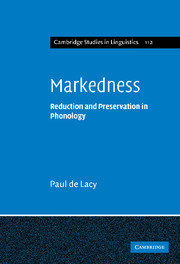
-
Select format
-
- Publisher:
- Cambridge University Press
- Publication date:
- September 2009
- August 2006
- ISBN:
- 9780511486388
- 9780521839624
- 9780521142236
- Dimensions:
- (228 x 152 mm)
- Weight & Pages:
- 0.85kg, 466 Pages
- Dimensions:
- (229 x 152 mm)
- Weight & Pages:
- 0.68kg, 468 Pages
You may already have access via personal or institutional login
Book description
'Markedness' refers to the tendency of languages to show a preference for particular structures or sounds. This bias towards 'marked' elements is consistent within and across languages, and tells us a great deal about what languages can and cannot do. This pioneering study presents a groundbreaking theory of markedness in phonology. De Lacy argues that markedness is part of our linguistic competence, and is determined by three conflicting mechanisms in the brain: (a) pressure to preserve marked sounds ('preservation'), (b) pressure to turn marked sounds into unmarked sounds ('reduction'), and (c) a mechanism allowing the distinction between marked and unmarked sounds to be collapsed ('conflation'). He shows that due to these mechanisms, markedness occurs only when preservation is irrelevant. Drawing on examples of phenomena such as epenthesis, neutralisation, assimilation, vowel reduction and sonority-driven stress, Markedness offers an important insight into this essential concept in the understanding of human language.
Reviews
Review of the hardback:'In this extraordinarily detailed and empirically rich work, framed within Optimality Theory, de Lacy argues that substantive featural markedness is part of linguistic competence.'
Source: Phonology
Review of the hardback:'… de Lacy's theory is the first that provides a comprehensive and coherent framework for inquiring into formal markedness. Once the notion of markedness is defined in such an explicit way, it is easier to examine more of its effects empirically and find its proper formal expression in a theory of grammar.'
Tanaka Shin-ichi - University of Tokyo
Contents
Metrics
Altmetric attention score
Full text views
Full text views help Loading metrics...
Loading metrics...
* Views captured on Cambridge Core between #date#. This data will be updated every 24 hours.
Usage data cannot currently be displayed.
Accessibility standard: Unknown
Why this information is here
This section outlines the accessibility features of this content - including support for screen readers, full keyboard navigation and high-contrast display options. This may not be relevant for you.
Accessibility Information
Accessibility compliance for the PDF of this book is currently unknown and may be updated in the future.


